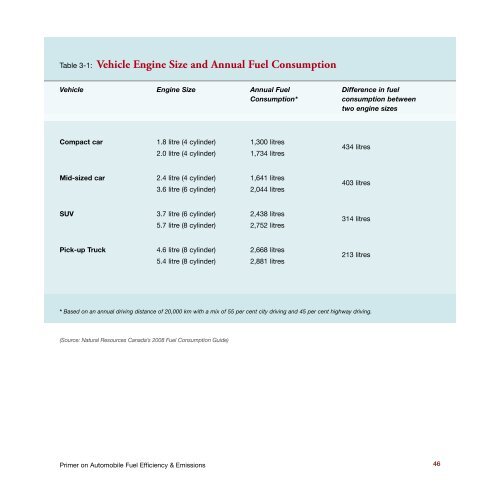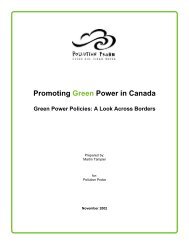Primer on Automobile Fuel Efficiency and Emissions - Pollution Probe
Primer on Automobile Fuel Efficiency and Emissions - Pollution Probe
Primer on Automobile Fuel Efficiency and Emissions - Pollution Probe
You also want an ePaper? Increase the reach of your titles
YUMPU automatically turns print PDFs into web optimized ePapers that Google loves.
Table 3-1: Vehicle Engine Size <strong>and</strong> Annual <strong>Fuel</strong> C<strong>on</strong>sumpti<strong>on</strong><br />
Vehicle Engine Size Annual <strong>Fuel</strong> Difference in fuel<br />
C<strong>on</strong>sumpti<strong>on</strong>*<br />
c<strong>on</strong>sumpti<strong>on</strong> between<br />
two engine sizes<br />
Compact car 1.8 litre (4 cylinder) 1,300 litres<br />
2.0 litre (4 cylinder) 1,734 litres<br />
434 litres<br />
Mid-sized car 2.4 litre (4 cylinder) 1,641 litres<br />
3.6 litre (6 cylinder) 2,044 litres<br />
403 litres<br />
SUV 3.7 litre (6 cylinder) 2,438 litres<br />
5.7 litre (8 cylinder) 2,752 litres<br />
314 litres<br />
Pick-up Truck 4.6 litre (8 cylinder) 2,668 litres<br />
5.4 litre (8 cylinder) 2,881 litres<br />
213 litres<br />
* Based <strong>on</strong> an annual driving distance of 20,000 km with a mix of 55 per cent city driving <strong>and</strong> 45 per cent highway driving.<br />
(Source: Natural Resources Canada’s 2008 <strong>Fuel</strong> C<strong>on</strong>sumpti<strong>on</strong> Guide)<br />
<str<strong>on</strong>g>Primer</str<strong>on</strong>g> <strong>on</strong> <strong>Automobile</strong> <strong>Fuel</strong> <strong>Efficiency</strong> & Emissi<strong>on</strong>s<br />
46
















